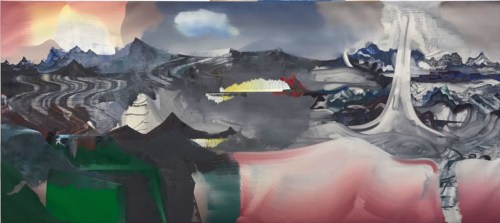
Elliott Green’s show at Pierogi is an eye-opener. The dozen ambitious canvases exude enormous confidence and verve, and more than most contemporary abstract painting, bring the once-radical genre of abstract-expressionism back to its original roots. While essentially abstract, these works are nothing if not expressive on a purely visceral level, a painted barometer of a roiling subconscious encountering disorienting change.
The mostly large-scale canvases, which feature saturated, almost-violent colors and jagged, cascading, swirling forms, evoke severely fractured (if not literally fracked) landscapes, and convey a strong emotional force. At the same time, they stir uneasy visions of a toxic environment: are we looking at the end results of climate change, where volcanoes erupt into melting icebergs, leaving deceptively calm azure lagoons? Or are we sharing visions of the Martian-like landscape to which the future human race has been banished, once we have permanently poisoned the planet?
When it first transformed the art world, Ab-Ex, greatly influenced by the then new and innovative theories of Freud and Jung, gave American artists permission to express individual responses to the Zeitgeist, as opposed to the collective political response of, say, the Social Realist work of the previous decade. As Arshile Gorky wrote at the time, “The stuff of thought is the seed of the artist. Dreams form the bristles of the artist’s brush. And as the eye functions as the brain’s sentry, I communicate my most private perceptions through my art, my view of the world.
Green’s dreams–and his view of the world–seem to push not only the bristles of his brush, but the myriad other methods with which he layers color onto canvas, from dragging a sponge dipped in graphite-infused paint to create a tubular, grey, worm-like entity with an iterative rippled skin, to bright, opaque tectonic slabs of paint, to gauzily radiant washes—numinous intervals which appear between curtains of sky in several works. These are landscapes that veer between Shangri-La and hell. What’s unique about Green’s paintings is how they merge views of the external world with the internal world, as if simulating the artist’s psyche: landscape as free-association; topology rendered through id.
But while their form may at first appear untrammeled, Green, an auto-didact who has been painting for decades, has an innate sense of composition. It might take the viewer’s eye a minute to adjust to the unexpected juxtaposition of various not-unfamiliar shapes. But each of these unsettling environments is a balancing act: the deft juggling of elements that emulate recognizable shapes in nature, reconfigured to create something totally new, but nonetheless holistic.
Green’s canvases have conviction: they assert a potent personal vocabulary. That vocabulary consists, among other things, of mountain-like ridges, lake-like expanses, lava-like ruptures, plant-like fronds, and the afore-mentioned Borealis-infused sheets of radiance. Employing these elements from canvas to canvas, in different vivid hues, configurations and paint modalities, Green creates a convincing, kaleidoscopic view of his interior/exterior world.
Interestingly, his titles reference that symbiotic relationship. One of the most powerful pieces in the show, Mineral Ancestors, seems to be in direct dialogue with Human Nature, the show’s equally potent title painting. Both feature a volcanic flow of red rimmed by yellow. Both have hopeful hints of green. And both have that trademark transcendental shimmer of light parting the sky.
A smaller, quieter canvas, like Hunger, seems almost Zen-like by comparison, its somewhat more subdued colors—brown, black and green–in relative—if still uneasy–harmony. Another small piece, Psychoid Moraine, with its balanced bands of yellow top and bottom and its ribbons of ripples and waves, each executed in a different technique, is a visual Haiku. Its title neatly combines a reference to [collective] human consciousness (notice the Jungian term, psychoid) with a reference to primal geology, a sort of fractal expressionism; Green’s original brand of Neo-Abstraction.
Written by Phoebe Hoban